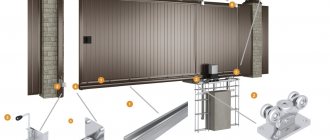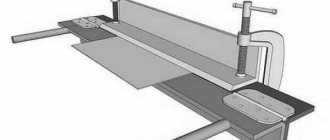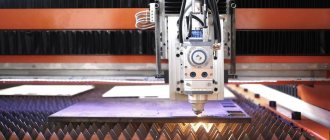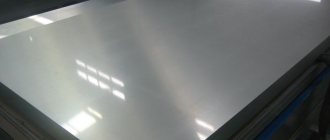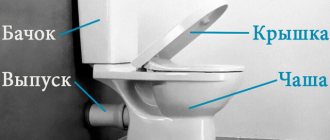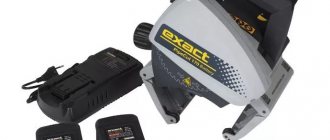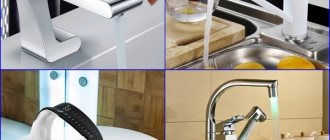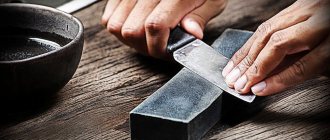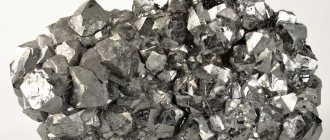Corrugated sheeting is the most used material in construction. Essentially, profiled flooring is a sheet of galvanized metal, covered with a polymer film and having a relief profile. At its core, a profiled sheet is a thin sheet of metal with extruded longitudinal recesses. Thanks to the profile, the sheet acquires rigidity, which allows it not to vibrate, sag or sag. These properties make it possible to use this building material to impart spatial strength without the use of an additional frame. Profiled sheet, or as it is sometimes called, corrugated sheet, is manufactured in a factory. The video below will give you an idea of the production process.
Types of corrugated sheets
This building material is distinguished by the type of application and by the polymer material with which the sheet is covered. The marking uses letter designations indicating the main area of application: “C” - wall, “H” - load-bearing, and “NS” - load-bearing wall. Wall profiled sheets are used for cladding the facades of buildings and structures, erecting fences and as roofing. The small thickness of the metal makes installation easier and faster. Load-bearing corrugated sheeting is used as floor and ceiling cladding, interfloor covering and in the construction of floors. This sheet is often used in the construction of garages, hangars, and prefabricated industrial premises. Load-bearing wall can be called a universal material; it can withstand loads higher than other brands of flooring and is used in all of the above cases.
Examples of using
Criteria for the correct selection of corrugated sheets
Experts say that the thicker the profiled sheet is purchased, the more reliable it is.
Important! The material is of considerable thickness and has good resistance to corrosion, can withstand significant loads from wind and snow, and can therefore be used in difficult conditions for a long time.
To select the right quality roofing material, important criteria are taken into account:
- Sheet thickness. The larger it is, the heavier and more reliable the profiled sheet will be. It is advisable to choose an average value so that the loads on the rafter system, the Mauerlat and the structure as a whole are small, but at the same time the sheets cope well with various influences.
- Metal consumption. The parameters and composition of the steel used to create the material directly affects the weight of the sheet, so before direct purchase it is recommended to carefully study the quality of the available material. It is advisable to focus on purchasing a premium grade of steel, as this will have a positive effect on the service life and quality of the coating.
- Wave height. The higher it is, the greater the mass and load-bearing capacity of the profiled sheet. The high profile further reduces the usable area of the material, which leads to an increase in its consumption during the formation of the roofing covering.
- Presence of anti-corrosion coating. It ensures the resistance of the sheets to the corrosion process, but at the same time significantly increases the weight of the roofing covering.
Thus, when choosing a material, you need to take into account many different criteria that allow you to get a truly high-quality and durable coating; in addition, read: which corrugated sheeting to choose for the roof.
Video on the topic:
Basic parameters of the profiled sheet
The thickness of the sheet, depending on the brand, can be from 0.4 to 1.5 mm. Weight of zinc coating per 1 sq. m. is 275 grams, and the thickness of the polymer coating is 25-200 microns. Profiled sheets can also be made to individual sizes based on the characteristics of the facility under construction. It should still be noted that the use of standard size sheets simplifies installation and calculation and has standard technical characteristics. Here is the marking of the most common profiled sheet: C8 1150/1200, here “C” means the area of application - wall, “8” is the height of the profile, and 1150 is the useful width of the sheet. Brand C8 is a leader in sales. A special feature of this profiled sheet is the low thickness and width of the profile shelves, which exceeds the height of the profile.
Profiled sheet C8 1150
Review of popular brands
To find out how much corrugated sheet metal weighs, let's look at several popular brands often used in the construction of roofs and fences.
Brand C21
C21 corrugated sheets are made from galvanized sheet metal. Waves made in the shape of a trapezoid add rigidity. Most often this brand is used in the construction of fences and partitions. The increased rigidity of the profile prevents sagging, which reduces the consumption of material for additional production of frame fastening elements. You can find out the weight of C21 corrugated sheets with different metal thicknesses from the table. For example, the mass of 1 p/m with a thickness of 0.6 and a width of 1250 is equal to 6.4 kg. If we take the weight of 1 m2 of a product with the same parameters, then it will also be equal to 6.4 kg.
Brand N114
Let's determine the weight of N114 corrugated sheeting, often used for roofing construction. It is used in regions where poor climatic conditions prevail. The material is able to withstand heavy snow loads and strong gusts of wind. The large weight of N114 corrugated sheeting determines its high strength, which allows it to be used in the construction of permanent formwork for monolithic structures. We will calculate the mass of corrugated sheet N114 based on the thickness of the steel, which has a range of 0.7–1.2 mm. If you look at the table, you can see that the sheets of this brand are much heavier, for example, compared to the C21 brand.
Take, for example, a sheet with a thickness of 0.7. According to the table, the weight of corrugated sheeting N114–750 is 8.3 kg/1 p/m. Now let's find out the weight of 1 m2 of the product. We return to the same table, where we see that the mass of corrugated sheet N114 with a size of 1 m2 exceeds 1 p/m and is equal to 11.10 kg. If we take it from thick steel 1, then its mass will be even more impressive. For example, the weight of corrugated sheet N114–750–1.0 is 15.6 kg/m2.
The H114 grade is produced with a working area of 600 and 750 mm. Strength is ensured by trapezoidal profile shapes. Due to its smaller dimensions, less load falls on a 600 mm wide sheet, so the upper wave crossbar consists of 1 stiffener rib.
Brand C8
The appearance of the waves of the C8 corrugated sheet resembles the shape of a trapezoid. The profile has a height of 8 mm. The table below indicates the weight of c8 corrugated sheets depending on its thickness. Let's take, for example, profiled sheet C8-1150 with a thickness of 0.4. From the table you can see that 1 m/p is 4.45 kg, and 1 m2 is 3.87 kg.
C8 corrugated sheets are used in the construction of light structures. These may be partitions, fences of private plots and other fragile structures. The use of C8 corrugated sheet as a roofing covering is unjustified. It is durable, but not strong enough to withstand heavy snow loads. Profiled sheet C8 has gained popularity among summer residents due to its low cost without sacrificing good characteristics.
Brand N75
N75 corrugated sheeting is used as a roofing covering. The increased strength profile is able to withstand heavy loads, both in vertical and horizontal positions. N75 corrugated sheets are made from galvanized steel sheets. The products are produced in different sizes. If we take, for example, a product with a thickness of 0.7 mm and a width of 1250, then 1 m2 will equal 9.8 kg. The mass of 1 m2 with a thickness of 0.9 will already be 12.5 kg. To make it easier to determine the weight of an H75 product, tables are similarly used.
Brand NS35
NS 35 corrugated sheets are made from galvanized sheet metal or galvanized metal with a protective polymer layer. The material is used for covering roofs with a slight slope, in the construction of prefabricated buildings, fences and other structures. Trapezoidal waveforms give the material increased strength, with relatively little weight. If we take from the table the material with the largest thickness of 0.8 mm, then 1 m2 is equal to 8.4 kg. The thinnest profiled sheet is 0.4, only 4.45 kg/m2.
From the examples considered, we can conclude that, despite its high strength, the corrugated sheet has a low weight, and it is necessary to know it in order to correctly carry out calculations of the roof rafter system.
We recommend reading:
- How much does slate weigh?
- What should be the slope for a corrugated roof?
Weight of corrugated sheets, tables
An important parameter when choosing a building material is its weight. Weight depends on the alloy, profile height, sheet thickness. “C” grade corrugated sheeting is the lightest, one linear meter weighs in the range of 4.46-8.38 kilograms. For load-bearing wall profiled sheets, the weight also starts at 4.46 kg. per linear meter and can reach 9.5 kilograms for sheets with high corrugation. The supporting corrugated sheet is made of thicker rolled metal, therefore it has the heaviest weight. Starting from 5.63 kilograms for H57 sheets and reaching 18.09 kilograms for H153 grade. You can easily find out the weight of corrugated sheets on the Internet. As an example, we present several tables of the most common material of different brands.
Table 1
| Brand | Sheet thickness in mm | Sheet width in mm | Weight of 1 linear m./1 sq. m. sheet in kg |
| C8 | 0,5 | 1150 | 5,40/4,70 |
| C8 | 0,55 | 1150 | 5,90/5,13 |
| C8 | 0,70 | 1150 | 7,40/6,43 |
| C10 | 0,5 | 1000 | 4,77 |
| C10 | 0,55 | 1000 | 5,21 |
| C10 | 0,70 | 1000 | 6,50 |
table 2
| Brand | Sheet thickness in mm | Sheet width in mm | Weight of 1 linear m./1 sq.m. sheet in kg |
| NS35 | 0,5 | 1000 | 5,40 |
| NS35 | 0,55 | 1000 | 5,90 |
| NS35 | 0,70 | 1000 | 7,40 |
| NS44 | 0,5 | 1000 | 5,40 |
| NS44 | 0,55 | 1000 | 5,90 |
| NS44 | 0,70 | 1000 | 7,40 |
Table 3
| Brand | Sheet thickness in mm | Sheet width in mm | Weight of 1 linear m./1 sq.m. sheet in kg |
| H60 | 0,7 | 845 | 7,40/8,76 |
| H60 | 0,8 | 845 | 8,40/9,94 |
| H60 | 0,9 | 845 | 9,30/11,01 |
| H114 | 0,8 | 600 | 8.40/14 |
| H114 | 0,9 | 600 | 9,30/15,50 |
| H114 | 1 | 600 | 10,30/17,17 |
To determine the weight of a square meter of profiled sheet, the weight of one linear meter is multiplied by the total length.
Influencing factors
Many people determine the weight of a corrugated sheet by its dimensions. This is not entirely true, since 2 products of the same dimensions, but different brands have different weights. This value is determined by the thickness of the material, the shape and size of the wave, as well as the mass of the steel alloy from which it is made.
Most often it is made of galvanized metal, but alloys can be used. Each raw material has its own weight and plays one of the main roles in forming the mass of the finished product. Modern technologies make it possible to use alloys of different metals in the production of profiled sheets. Due to this, the manufacturer tries to reduce material costs, but not at the expense of its strength.
Another important factor is thickness . There is a standard GOST 24045-94, according to which manufacturers produce products 0.6–1 mm. Sometimes in retail outlets you can find products 0.45–1.18 mm.
Products of any brand have a wave. The greater its height, the heavier the product will be. So why is the weight per square meter of corrugated sheeting of the same thickness, but with different wave heights, so different? It all depends on the amount of metal falling per 1 m2 of the product. A high wave requires more steel or alloy to produce than a low profile, so the overall result will vary.
In addition to height, the wave differs in its shape. The profile of the corrugated sheet is made rectangular, trapezoidal or traditional wave. If we take, for example, a specimen with a trapezoidal profile, then its weight of 1 m2 will exceed the mass of a similar-sized wavy product.
The last factor to consider is width. There are two concepts: working area and total. The difference between these two definitions is the width of the overlap. The product manufactured in accordance with GOST has a total width range of 646–1060 mm. The width is affected by the same wave height indicator. The higher the wave, the narrower the product, but the weight of 1m2 is greater.
Video description
You can clearly see how sheet steel turns into corrugated sheets in the following video:
Profiled sheets are produced in accordance with GOST 24045-2010, which regulates their parameters and technical characteristics. They must be marked indicating the purpose of the material, profile height and working width of the sheet.
Note! The working (or useful) width is not equal to the total width. It is indicated without taking into account overlaps and is taken to calculate the area covered by the material. The total width is usually greater than the working width by one wave.
An example of determining the difference between the total and usable width Source pvh-membrannaya-krovlya.ru
See also: Catalog of companies that specialize in interior and exterior decoration
The markings are easy to understand. For example, H57-750 means that in front of you is a load-bearing material with a wave height of 57 mm and a working sheet width of 750 mm.
But products of different thicknesses, with or without a protective coating, can have such markings. And the thickness of the coating can be different. Therefore, when buying a C8 profiled sheet, it is not enough to know the dimensions of the sheet - you also need other parameters on which the weight of the product depends. It is determined from the table. For galvanized corrugated sheets without a polymer coating, it looks like this:
| Sheet thickness, mm | Weight along working width, kg/m² | |||||||
| C8 | C10 | C17 | NS35 | H57 | H60 | H75 | H114 | |
| 0,4 | 3,52 | 3,68 | 3,72 | 4,05 | 4,75 | 4,79 | 5,40 | 6,75 |
| 0,45 | 3,95 | 4,13 | 4,17 | 4,54 | 5,33 | 5,37 | 6,05 | 7,57 |
| 0,5 | 4,38 | 4,57 | 4,62 | 5,03 | 5,90 | 5,95 | 6,71 | 8,39 |
| 0,6 | 5,23 | 5,47 | 5,52 | 6,01 | 7,05 | 7,12 | 8,02 | 10,02 |
| 0,7 | 6,08 | 6,36 | 6,42 | 6,99 | 8,21 | 8,28 | 9,33 | 11,66 |
| 0,8 | 6,93 | 7,25 | 7,32 | 7,98 | 9,36 | 9,44 | 10,63 | 13,29 |
| 0,9 | 7,79 | 8,14 | 8,22 | 8,96 | 10,51 | 10,60 | 11,94 | 14,93 |
| 1,0 | 8,64 | 9,03 | 9,12 | 9,94 | 11,66 | 11,76 | 13,25 | 16,56 |
| 1,5 | 12,91 | 13,49 | 13,62 | 14,84 | 17,42 | 17,57 | 19,79 | 24,74 |
Unpainted corrugated sheeting Source krovlyamoya.ru
Premises requirements
The room in which the corrugated sheet will be stored must meet the following requirements:
- According to GOST 15150-69, it must be unheated. The temperature of the sheets must correspond to the ambient temperature.
- It should not be exposed to direct sunlight.
- It must be closed. The roof and walls must reliably protect the corrugated sheet from rain and snow.
- The room must have natural ventilation. If the air stagnates, condensation may form on the steel sheets.
Ideal premises for storing corrugated sheets are a warehouse, an outbuilding, a basement with good ventilation. You can store corrugated sheets in them from autumn to spring.
In summer, it is permissible to store corrugated sheets outdoors under a canopy, but this is not the best option - precipitation and dust will get on the material.
Length and width of corrugated sheets
The weight of corrugated sheets also depends on the size of the profiled sheets. The length of the corrugated sheets can be different, since they are made from rolled steel, and the length depends only on the dimensions that the customer wants to see. When calculating the length of a roofing sheet, not only the length of the roof slope is taken into account, but also the canopy.
The width of the sheets is another important indicator when calculating the weight of corrugated sheets. The width of the profiled sheet varies from 980 mm to 1850 mm. Since the sheets should be laid “overlapping”, the useful width is often 40-80 mm less than the actual one.
The dimensions of the corrugated sheet can be different, it depends on the purpose of the corrugated sheet. Sizes range from 2.4 to 12 m, for different types with different pitches. Standard sizes of corrugated sheeting are usually used for roofing large buildings, due to the fact that it can be folded in a certain order, this makes the structure original and decorative. Regardless of the size, sheets of profiled flooring have good technical characteristics, such as strength, reliability, and durability.
Size of corrugated sheet by thickness and height
The thickness of the metal and the height of the corrugation also affect the weight of the corrugated sheet. The thicker the corrugated sheet, the more durable it is. The standard metal thickness is 0.5 and 0.55 mm, as well as 0.7; 0.8 mm and 1 mm. When choosing thickness, you should take into account the area of the object to be coated, loads and climate.
The height of corrugated sheets varies quite widely. The height is the distance between two adjacent corrugations. The larger the corrugation size, the more voluminous the coated object looks. The height can be from 15 to 130 mm, and depends on the design. When using corrugated sheets for fencing, a sheet of low corrugation is usually used. Larger sheets of corrugated sheets are used in the construction of buildings, as well as roofing and facade materials.
Characteristics and advantages of the material
sheeting is an affordable, practical roofing material that is made from thin rolled steel in the form of rectangular sheets of different sizes with a trapezoidal profile extruded into it with a special press. It is made from galvanized steel with paint or polymer coating, which increases the anti-corrosion properties of the material. Manufacturers produce load-bearing, wall and universal profiled grades of corrugated sheeting, differing in thickness, weight and profile height. Roofs covered with this inexpensive material have the following advantages:
- Light weight corrugated board. It weighs less than any other modern roofing covering, which reduces the cost of transportation, rafter framing and structure installation. The weight of 1 m2 of profiled sheet does not exceed 8-10 kg, while 1 m2 of traditional ceramic tiles weighs 35 kg.
- Durability. The material's resistance to corrosion, temperature changes, fungus and rotting makes corrugated sheeting a reliable and durable roof covering that can withstand 15-15 years of intensive use.
- Strength. Profiled sheets have a high load-bearing capacity, which allows them to withstand significant snow loads.
- Ease of installation. The standard dimensions of the sheet of material are suitable for economically covering the roof of any area; in addition, installation is carried out without the use of special equipment or tools.
Structure of a profiled sheet
The production process of C-10 grade corrugated sheets
Note! The light weight of corrugated sheeting allows this durable, reliable roofing material to be used for reconstruction or partial repair of old slate or tile roofs without dismantling the structure over the worn-out covering.
Types of corrugated sheets depending on the coating
- The corrugated sheets are made of galvanized steel , but no protective coating is applied.
- The sheet is produced through the hot-dip galvanizing process.
- Hot-dip galvanized production technology with the application of an additional polymer coating.
- The corrugated sheet is made of chrome-plated nickel steel or aluminum and copper.
- For certain types of work, various types of embossing are made to order on sheets and bent into the required shapes or radii.
Storing profiled sheets: common mistakes
To prevent the profiled sheet from deteriorating during storage, it is strictly prohibited:
- Allow stacks of material or individual sheets to move relative to each other.
- Use a grinder near stacks - sparks can hit the material and damage the polymer and zinc coating.
- Cover the stacks with cloth, film, etc. This interferes with ventilation; the air between the stacks and sheets will stagnate.
- Place heavy objects on stacks. This will lead to deformation of the sheets.
- Allow contact of the corrugated sheet with copper surfaces. When galvanized steel and copper come into contact, a chemical reaction occurs and the steel begins to rust.
- Store corrugated sheets in a vertical position, for example, leaning the sheets against the wall. The answer to the question “Is it possible to store corrugated sheets vertically?” categorical: no. This will lead to deformation of the material.
- Place thin, light packages of corrugated sheets at the bottom of the stack, and thick, heavy ones at the top. Thicker bundles can support more weight and are stacked first. Each package of corrugated sheets includes a passport, which indicates the length and weight of the pack. Focus on this data when you stack material.
- Place packages/sheets of different lengths (even the same weight) in one stack. For example, you bought 2 packs of corrugated sheeting with a thickness of 0.5 mm: the first contains 10 sheets 7 meters long, the second contains 50 sheets 1.5 meters long. If you place a second package on top of the first, the package with long sheets will become deformed, because the weight will be concentrated in its central part.
- Store corrugated sheets outside during the cold season (autumn, winter).
What is the difference between roofing sheets and corrugated sheets?
Profiled sheets are tougher, more durable than corrugated sheets, and their range is much larger.
Corrugated sheeting is characterized by a high degree of noise absorption, but when finishing the roof with corrugated sheets, it is necessary to additionally use soundproofing materials. Also, due to the fact that corrugated sheeting is a rigid structure with complex terrain, this allows it to be used during installation at any height, and it can withstand heavy loads.
In fact, corrugated sheets and corrugated sheets are the same material , only corrugated sheets are most often called roofing material, and corrugated sheets are a universal coating.
Profiled sheets depending on the scope of application
- Corrugated sheeting for the manufacture of fencing . The weight of the profiled sheet allows you to make fences without constructing strong foundations. Strength while resisting wind loads is provided by stiffening ribs. A wide variety of colors allows you to create a fence in accordance with the chosen exterior of the yard and protect property from strangers.
- Corrugated sheets are most often used for finishing facades Currently, types of corrugated sheeting have been developed and created that imitate natural stone and different types of wood. Visually, the result is wooden houses with a stone base, which is very interesting from the designer’s point of view.
- Corrugated sheets are also used for fencing the walls of temporary work sites, dividing large outbuildings into various sections, warehouses, hangars, workshops and summer premises. Considering how much corrugated sheeting weighs, massive foundations are not required for their installation, which significantly saves money.
- Using corrugated sheets in roof finishing allows you to get a finished, beautiful building with a pleasant aesthetic appearance. The material is easy to install and cut to size. The small weight of m2 of corrugated sheeting allows you not to weigh down the roof structure. The length of the sheet is up to 6 m, which allows you to avoid transverse joints when installing the roof.
- Uncoated corrugated sheets are used as formwork when concreting foundations, which guarantees additional protection of the foundation walls from the aggressive effects of groundwater.


